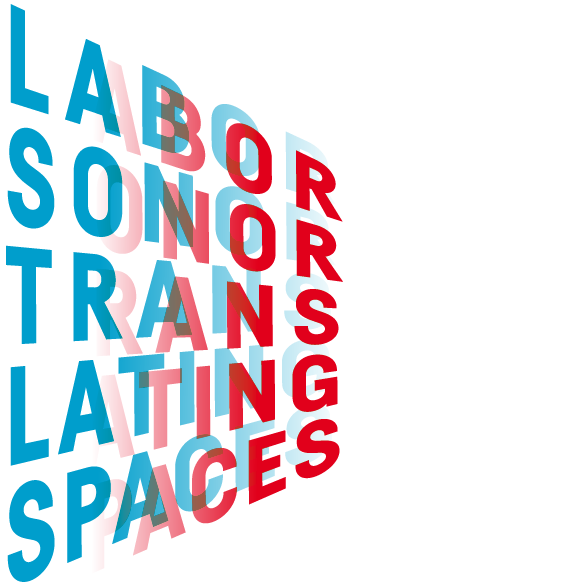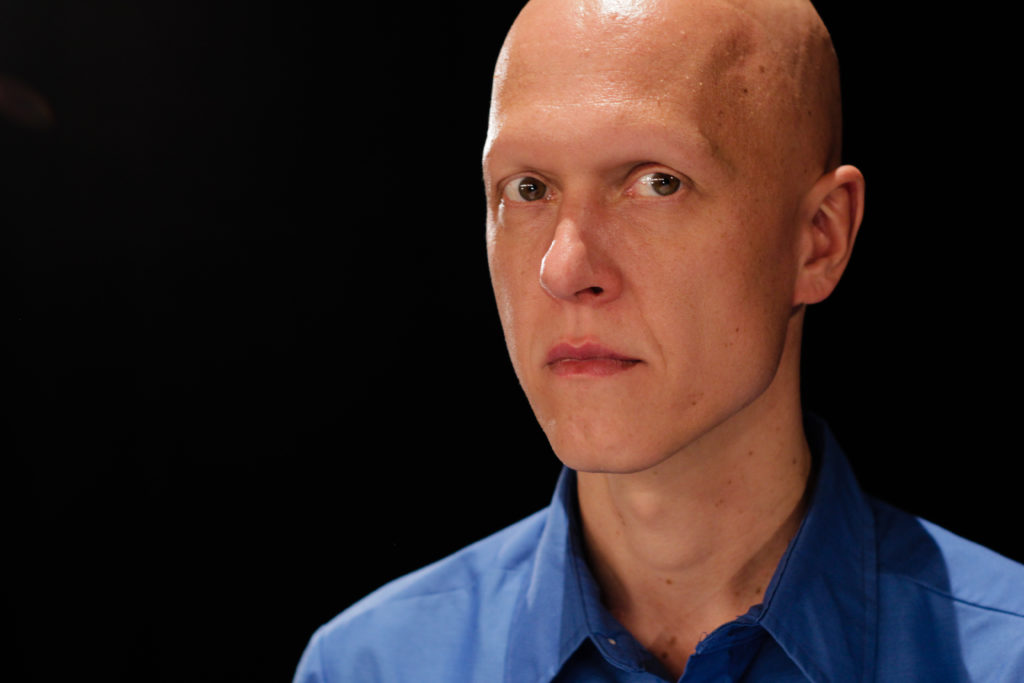
Christian Kesten
translating a frontal into a multi-perspective listening situation
SPACING PLACES
Fünf Instrumente, fünf Menschen, die Instrumente spielen, im Raum.
Sie wechseln im Laufe des Stückes ihre Positionen, nehmen unterschiedliche Abstände zueinander ein, spielen entfernter oder näher zusammen. Es entstehen unterschiedliche Konstellationen der gespielten Klänge im Raum, wechselnde Klang-Architekturen, die im Spiel von Nähe und Distanz den Zuhörenden den Raum akustisch erfahrbar machen. In der Übersetzung des Zweimalspielens werden der weite, hohe Raum der Elisabethkirche und der Saal der Villa Elisabeth in ihrer Verschiedenheit akustisch ausgelotet. Während in der Elisabethkirche die Zuhörenden zeitweise weit vor dem Geschehen sitzen und so den Raumklang vor allem in der Tiefe, aber auch im Panorama erleben, befinden sie sich im Saal der Villa Elisabeth in der Mitte des Raumes, in der Mitte des Klanggeschehens. Die Klänge wandern um die Zuhörenden herum. Die Klang-Positionswechsel werden analog zur Kirche auf den Villa-Saal projiziert. Den Dimensionen der Kirche entsprechen teilweise Positionen außerhalb des Saals, die Instrumente spielen zeitweise aus Nebenräumen und Treppenhäusern. Die Erfahrung des akustischen Raums weitet sich über die gesetzten architektonischen Wände hinaus.
Die Instrumentalist_innen werden durch die Positionswechsel als körperliche Individuen erlebbar, treten in immer andere Beziehungen zueinander, telepathische, intime, auch in immer andere Beziehungen zu den Zuhörenden. Aktionen wie Gehen, Stehen oder Sitzen werden Teil des Geschehens. Der Körper wird zum Instrument. Hören, Zuhören, ist der Ausgangspunkt aller Aktivitäten.
Ariel Garcia, Taschentrompete
Henrik Kairies, Akkordeon
Yodfat Miron, Viola
Seijiro Murayama, Snaredrum & Stimme
Michiko Ogawa, Klarinette
St. Elisabeth Kirche, Invalidenstraße 4A, 10115 Berlin
Samstag 28.08.21 18:00 / 19:00 / 20:00 / 21:00
Dauer: ca. 40 min
Villa Elisabeth, Saal, Invalidenstraße 4, 10115 Berlin
Sonntag 29.08.21 18:00 / 19:00 / 20:00 / 21:00
Dauer: ca. 40 min
video documentation—concept, edited by: Isabell Spengler
camera by: Lilli Kuschel, Stefan Korsinsky, Isabell Spengler
sound recorded by: Adam Asnan, Francisco Petrucci
sound mixed by: Adam Asnan
SPACING PLACES
Five instruments—five people playing instruments—within a space.
During the course of the piece they change positions, assuming different distances to each other, playing more distantly or closer together. Different constellations of sounds arise in the space, different sound architectures, the interplay of smaller and greater distances making the space acoustically perceivable for the listeners. The translation process of playing twice acoustically explores the wide, high space of the Elisabethkirche and the hall at the Villa Elisabeth and their differences. At the Elisabethkirche the audience is seated in front of the action, and at times the positions of the performers are far removed from the listeners. Thus the listeners experience the spatial sound primarily in depth, but also in panorama. At the hall of the Villa Elisabeth they are in the middle of the room, in the middle of the sound event. The sounds wander around the listeners. The changing positions are projected onto the Villa hall analogously to the church. The dimensions of the church mean that corresponding positions are located outside the hall, so that the instruments occasionally play from adjoining rooms and stairwells. The experience of the acoustic space expands beyond the existing architectural walls.
The instrumentalists can be experienced as physical individuals through the changes of position; they enter into ever different relationships with each other, telepathic, intimate, also into ever-changing relationships with the listeners. Actions such as walking, standing or sitting become part of the event. The body becomes an instrument. Hearing, listening, is the point of departure for all activities.
Ariel Garcia, pocket trumpet
Henrik Kairies, accordion
Yodfat Miron, viola
Seijiro Murayama, snare drum & voice
Michiko Ogawa, clarinet
St. Elisabeth Kirche, Invalidenstraße 4A, 10115 Berlin
Saturday 8/28/2021 18:00 / 19:00 / 20:00 / 21:00
Duration: approx. 40 min
Villa Elisabeth, Saal, Invalidenstraße 4, 10115 Berlin
Sonntag 8/29/2021 18:00 / 19:00 / 20:00 / 21:00
Duration: approx. 40 min
video documentation—concept, edited by: Isabell Spengler
camera by: Lilli Kuschel, Stefan Korsinsky, Isabell Spengler
sound recorded by: Adam Asnan, Francisco Petrucci
sound mixed by: Adam Asnan

Christian Kesten ist Komponist, Regisseur, Klang- und Intermedia-Künstler, Vokalist und Performer. Sein künstlerisches Interesse gilt dem „Dazwischen“, den Zwischenräumen zwischen Musik und Aktion, Musik und Sprache, zwischen Musik und Skulptur. Seine Arbeiten erforschen die Durchdringung von Klang und Stille, Klang und Raum, mit einem Fokus auf die physische Aktivität der Klangerzeugung und die Materialität des Klanges selbst.
Er erhielt Kompositionsaufträge von Ensembles wie Marinate Fish Impro Committee Beijing, AuditivVokal Dresden, Chorakademie Dortmund, Object Collection New York, Rue du Nord Lausanne, WeSpoke London, dem Solistenensemble Kaleidoskop Berlin u.a., und realisierte abendfüllende Werke in Bühnenräumen wie Radialsystem V Berlin, Schauspielhaus Wuppertal, Théâtre 2.21 Lausanne, Witte de With Center for Contemporary Arts auf Festivals wie MIKROTON Bern, Ontological Experimental Series New York, Operadagen Rotterdam. Daneben entwickelte er ortsspezifische Arbeiten für Bahnhöfe, Kellerräume oder die drei Fahrstühle des Museums Moderner Kunst Wien. Seine Solo-Performances für Stimme, Körper, Objekte, Video-/Audio-Fieldrecordings zeigte er in Europa, Nordamerika und Japan.
Kesten erhielt 2015 und 2018 Arbeitsstipendien des Berliner Senats, 2016 das Civitella Ranieri Music Fellowship und viele weitere Förderungen.
Christian Kesten is a composer, director, sound and intermedia artist, vocalist and performer. His artistic interest lies in the ‘in-between’, the transitory, the spaces between music and action, music and language, music and sculpture. His work explores the interpenetration of sound and silence, of sound and space, with a focus on the physical activity of creating the sound, and the physicality of the sound itself.
Kesten received commissions by ensembles like Marinate Fish Impro Committee Beijing, AuditivVokal Dresden, Chorakademie Dortmund, Object Collection New York, Rue du Nord Lausanne, WeSpoke London, dem Solistenensemble Kaleidoskop Berlin a.o. He realised full-evening’s pieces in spaces like Radialsystem V Berlin, Schauspielhaus Wuppertal, Théâtre 2.21 Lausanne, Witte de With Center for Contemporary Arts at festivals like MIKROTON Berne, Ontological Experimental Series New York, Operadagen Rotterdam. He also created site-specific works for train stations, basements, and the three elevators of Museum for Modern Art MUMOK Vienna. Kesten delivered solo performances for voice, body, objects, video/audio field recordings in Europe, North America, and Japan.
He received awards and grants by the Berlin Cultural Senate, Ernst-von-Siemens-Musikstiftung, International Society of New Music, Civitella Ranieri Foundation, Villa Aurora Los Angeles, a.o.

Ariel Garcia widmet sich seit etwa fünfzehn Jahren verschiedenen musikalischen Aktivitäten, die von der Improvisation über die Komposition von Film- und Theatermusik bis hin zu New-Orleans-Jazz und elektronischer Musik reichen. Er ist Gründungsmitglied der Rue du Nord Association, die ihren Sitz in Lausanne hat. In Zusammenarbeit mit verschiedenen Künstler*innen beteiligt er sich auch an der Ausarbeitung von Performances oder Klanginstallationen.
Ariel Garcia has been devoting his time for the past fifteen years to various musical activities, ranging from improvisation to the composition of film and theater music, through new-orleans jazz and electronic music. He is a founding member of the Rue du Nord Association, based in Lausanne. In collaboration with various artists, he also participates in the elaboration of performances or sound installations.

Henrik Kairies, geboren in Braunschweig, ist Komponist, Musiker, Performer. Er studierte in Berlin. Seit 1991 ist er Mitglied der “Maulwerker” (nächstes Projekt: Orte & Räume #2). Als Komponist arbeitet er an verschiedenen Theatern. Er ist Gast bei der “Modularen Kollaboration“.
Henrik Kairies, born in Braunschweig, is a composer, musician and performer. He studied in Berlin. Since 1991 he has been a member of “Maulwerker” (next project: Orte & Räume #2). As a composer he works at various theatres. He is a guest at the “Modulare Kollaboration“.

Die Bratschistin und Performance-Künstlerin Yodfat Miron entstammt einer israelisch-jemenitischen Musikerfamilie. Sie war mehrfache Stipendiatin der America-Israel-Foundation und spielte Solo-Viola im West Eastern Divan Orchester unter Daniel Barenboim. Nach Abschluss ihres Viola-Studiums in Tel Aviv und Berlin begründete sie 2003 das Miron-Quartett. Seit 2013 ist sie ständiges Mitglied im Berliner Solistenensemble Kaleidoskop, in dessen Rahmen sie sich als Grenzgängerin zwischen schauspielerischer und instrumentaler Darstellung entwickeln konnte. 2016 interpretierte sie die Rolle des Joseph Beuys in Tom Patchetts und Georg Nussbaumers Stück „Jeder Hase ein Künstler. Eine Beuys Fabel.“ 2017 spielte sie Theodor W. Adorno in Clara Gervais’ Melodram „Über den Fetischcharakter in der Musik und die Regression des Hörens“ (Wiederaufnahme 2018). Anfang 2020 performte sie in der Uraufführung von Ulrike Rufs innovativer konzertanter Inszenierung „Viola Solo“ (Berlin, Januar 2020).
The violist and performance artist Yodfat Miron comes from an Israeli-Yemeni family of musicians. She was a multiple scholarship holder of the America-Israel-Foundation and played solo viola in the West Eastern Divan Orchestra under Daniel Barenboim. After completing her viola studies in Tel Aviv and Berlin, she founded the Miron Quartet in 2003. Since 2013 she has been a permanent member of the Berlin soloist ensemble Kaleidoskop, where she has been able to develop as a border crosser between acting and instrumental performance. In 2016 she interpreted the role of Joseph Beuys in Tom Patchett’s and Georg Nussbaumer’s play ‘Jeder Hase ein Künstler. A Beuys Fable.’ In 2017, she played Theodor W. Adorno in Clara Gervais’ melodrama “On the Fetish Character in Music and the Regression of Listening” (revival 2018). In early 2020, she performed in the world premiere of Ulrike Ruf’s innovative concert production ‘Viola Solo’ (Berlin, January 2020).

Seijiro Murayama, geboren 1957 in Japan, Musiker-Improvisator, spielt Schlagzeug oder Stimme. Seit 2000 arbeitet er in Frankreich in vielen verschiedenen Kontexten, insbesondere mit Catherine Diverrès (Tanz), Jean-Luc Nancy (Philosophie), Dominique Koch (Bildende Kunst), Dominique Collignon Morin (Theater). Aktuell spielt er im Duo mit Jean-Luc Guionnet, Axel Dörner, Klaus Filip und Cyprien Busolini.
Seijiro Murayama, born in Japan in ’57, musician-improviser, plays the percussion or the voice. Since 2000, he works in France in many different contexts, in particular with Catherine Diverrès (dance), Jean-Luc Nancy (philosophy), Dominique Koch (visual art), Dominique Collignon Morin (theatre). Actually he plays duo with Jean-Luc Guionnet, Axel Dörner, Klaus Filip, and Cyprien Busolini.

Michiko Ogawa ist eine auf die Klarinette spezialisierte Performerin und Komponistin, geboren und aufgewachsen in Tokio, Japan. Sie spielt nicht nur klassisches Repertoire, sondern auch zeitgenössische und experimentelle Musik, einschließlich freier Improvisation und Film-Soundtracks. Michiko Ogawa ist auf vielen internationalen Festivals aufgetreten. Sie hat mit Komponist*innen wie Toshi Ichiyanagi, Helmut Lachenmann, Catherine Lamb und Chikako Morishita zusammengearbeitet und arbeitet unter anderem mit den Musiker*innen Sam Dunscombe, Taku Sugimoto, Carolyn Chen und Klaus Lang zusammen. Sie arbeitet auch häufig mit bildenden Künstlerinnen zusammen, wie Angela Jennings, Lindsay Bloom, Brianna Rigg und Sabina Maselli.
Michiko Ogawa is a performer-composer specialising in the clarinet, born and raised in Tokyo, Japan. She performs not only classical repertoire but also contemporary and experimental music, including free improvisation and film soundtrack work. Michiko Ogawa has appeared at many international festivals. She has worked with composers including Toshi Ichiyanagi, Helmut Lachenmann, Catherine Lamb and Chikako Morishita, and has been collaborating with musicians Sam Dunscombe, Taku Sugimoto, Carolyn Chen, and Klaus Lang among others. She also frequently collaborates with visual artists, such Angela Jennings, Lindsay Bloom, Brianna Rigg and Sabina Maselli.